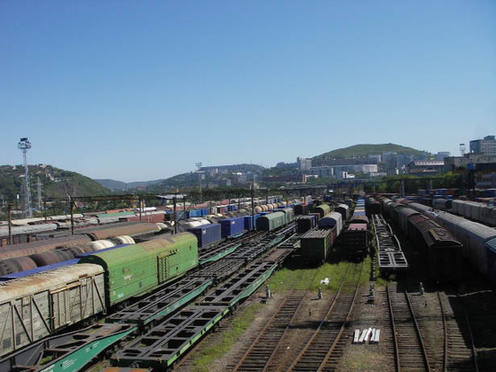By staff reporter VAUGHAN WINTERBOTTOM
 |
|
Vladivostok, on Russia's Pacific coast, is the Far East terminus of the Trans-Siberian Railway, the construction of which dates back to 1891. |
SILK, spices and camels are succeeded by computers, car parts and horsepower as an increasingly integrated rail network shortens the distance between Europe and China.
O European! If you only knew what your laptop went through to reach you. From its mother factory in Central China, your shiny new hardware was postnatally incarcerated for a week in an overflowing truck (and possibly tortured with leaded petrol fumes) before being catacombed in a container ship at a southern Chinese port. From there, it spent a month suffocating through the world's shipping bottlenecks: the Straits of Malacca, the Suez Canal, and then depending on whether you are of Germanic, Latin or Slavic descent, perhaps the Strait of Gibraltar or the Bosphoros. Your bundle of joy was 35-40 days old before you removed its swaddling packaging.
For the businessmen who brought your laptop into existence, this world tour is a hassle. These shipping lanes are extremely congested and support 60 percent of world shipping. Freight prices are usually high but vary wildly and unpredictably. Piracy is also a problem – the International Maritime Bureau's Piracy Reporting Center records 421 attacks last year, 231 of which occurred off the Somali coast.
Meanwhile, EU-China trade relations continue to grow. At present, the EU is China's largest trading partner and China is the EU's second largest after the U.S. It is estimated that by 2030, non-energy exports from the EU 25 to China will have tripled while EU imports from China will have grown by a factor of two to three. Capacity shortages and costing issues on shipping routes are only set to worsen.
A perfunctory glance at a globe suggests this circuitous shipping route makes little sense – straight lines drawn from Chinese factories to European consumers are thousands of kilometers shorter. Luckily, such straight lines do exist – they come in parallel pairs and are made of steel.
Cognizance of rail transport to Europe as a viable alternative to deep-sea routes is growing in China. This has happened as the Chinese government has been pushing for stronger economic growth in the country's traditionally poorer northern, central and western provinces. Export growth from China's landlocked hinterlands has averaged 25 percent per year for close to half a decade now. This growth has piqued interest in existing rail routes to the old continent as a more logical option than sending goods overland to China's coastal ports, often in precisely the opposite direction to Europe, before having them double back around Eurasia on ship.
For China's inland provinces, the "Europe express" emits five percent of the carbon of air transport and is quicker, should be simpler and could be cheaper than the inter-modal alternatives based on shipping. Freight along this Silk Railroad is starting to gather steam, albeit slowly. So why aren't we seeing more hanzi at the Hauptbahnhof?
| 